Do you have a website that touches on health and wellness in some way? That’s great! However, in this day and age, providing medical information online can be a double-edged sword.
This is why it’s advisable to protect your business by having a medical disclaimer. So, what is a medical disclaimer?
A medical disclaimer clarifies the scope of health-related information, products, or services. It explicitly states that the content or offerings are not substitutes for professional medical advice, diagnosis, or treatment.
Want to learn more? Let’s talk about their various types, importance, key components, and how you can draft and implement an effective disclaimer for your online platform.
- A medical disclaimer clarifies that your content is not medical advice, protecting you from liability and guiding readers to consult professionals.
- Display your medical disclaimer prominently on your website to ensure users are aware of its terms and limitations before engaging with your content.
- Regularly update your medical disclaimer to keep it aligned with legal regulations and changes in your content.
Table of Contents
PRO TIP: Take the hassle of writing your own disclaimer away with our disclaimer generator trusted by over 200,000 businesses. It’ll save you hours of work and possible costly legal mistakes.
Types of Medical Disclaimers
From general health disclaimers to more specific ones tailored to fitness, nutrition, or mental health content, knowing which type aligns with your business’s offerings can safeguard you and your audience.
Here are the most common types of medical disclaimers and how they can be effectively applied to your online presence.
Medical Advice Disclaimer
Any website that offers health-related information would benefit from a disclaimer on medical advice, like bloggers, health and wellness coaches, and anyone sharing general health tips.
This type of medical disclaimer clearly states that the content is not a substitute for professional medical care but instead provided for informational purposes only.
Health Disclaimer
A health disclaimer is broader than a medical advice disclaimer. Essentially, this type of medical disclaimer emphasizes that the content is general in nature and not tailored to specific individuals.
Websites discussing various health topics, such as nutrition or mental health, should have a solid health disclaimer in place.
In fact, even by saying something as simple as, “disclaimer not medical advice,” you’re already protecting your website from liability if someone applies the information incorrectly regarding a medical condition.
“I Am Not A Doctor” Disclaimer
An “I am not a doctor” disclaimer is a straightforward declaration that the website owner or author is not a medical professional. It is typically used by influencers and businesses that share wellness advice, personal experiences, or alternative medicine tips.
By explicitly stating their non-expert status, they reduce the risk of being misinterpreted as offering professional medical guidance. Instead, the site should encourage the reader to consult with and always seek the advice of your doctor.
PRO TIP: Use it together with other disclaimers to reinforce the idea that the content is, again, for informational purposes only.
Confidential Email Disclaimer for Medical Information
This notice is typically included in emails from healthcare providers or organizations handling sensitive health data. It informs recipients that the email may contain private medical information intended only for the designated recipient.
Healthcare professionals, medical institutions, and businesses dealing with patient information commonly use this type of disclaimer. It serves to protect patient privacy and comply with legal regulations such as HIPAA in the United States.
PRO TIP: While a disclaimer is important, use secure email platforms and encryption to safeguard patient data effectively.
Medical Disclaimers for Fitness Programs
This type of medical disclaimer stresses the importance of consulting a doctor before starting any new workout regimen, especially if they have underlying health conditions.
It also acknowledges the potential risks involved in physical activity and encourages individuals to listen to their bodies. This makes it ideal for gyms, fitness studios, and online fitness platforms.
Medical Disclaimer vs. Health Disclaimer
A medical disclaimer is more specific to medical topics, while a health disclaimer is broader, covering general health and wellness advice. Here is a comparison table between the two:
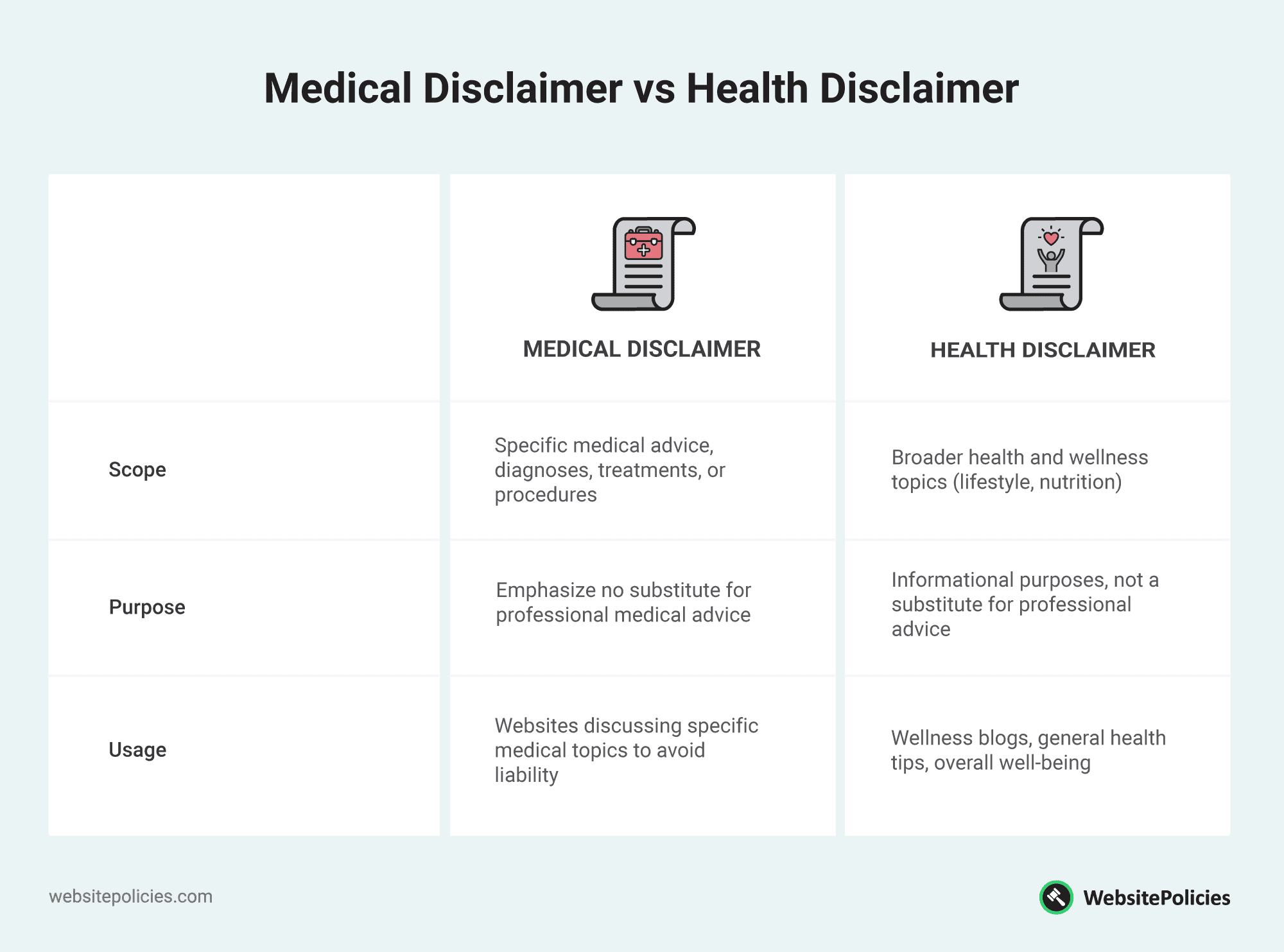
Who Needs a Medical Disclaimer?
Anyone providing health-related information or services needs a medical disclaimer. This includes any content creator who is not a licensed physician or other medical professional but shares advice that could be perceived as medical guidance.
Health and Wellness Blogs
Bloggers offering health tips or advice should include a medical disclaimer for blog posts to clarify that their content is informational and not professional advice.
Fitness Programs and Trainers
Those providing exercise regimens or fitness tips need disclaimers to inform participants about consulting a healthcare professional before starting new programs.
Medical or Health Websites
Websites discussing diseases, treatments, or medications must include disclaimers to ensure users understand the information should not replace professional medical consultations.
Diet and Nutrition Advisors
Individuals or businesses providing dietary advice should use disclaimers to emphasize that their recommendations are not substitutes for professional nutritionist consultations.
Alternative Medicine Practitioners
Providers of holistic or alternative therapies should include disclaimers to clarify that their methods are complementary and not replacements for conventional medical treatments.
Why Do You Need a Medical Disclaimer for Your Website?
You need a medical disclaimer for your website to protect yourself from legal liability and to ensure your audience understands the limitations of the information provided.
Essentially, you need one to:
- Protect yourself from liability: A medical disclaimer helps shield you from potential lawsuits if users rely on or use the information provided on your website and suffer harm.
- Inform your audience: Clearly stating that the information read on this website is not intended to be a substitute for professional medical advice helps set proper expectations.
- Encourage professional medical care: A disclaimer reinforces the importance of consulting with a healthcare provider for any medical concerns. Never disregard professional medical advice or delay in seeking it because of something you have read on your website.
- Disclaim responsibility: By including a medical disclaimer, you make it clear that you are not liable for any direct or indirect consequences resulting from the use of the information provided.
8 Key Components of a Medical Disclaimer
To ensure your disclaimer is effective, it’s crucial to include specific elements that clearly communicate its purpose. Here are eight key components that should be included in a medical disclaimer for websites:
1. Statement Clarifying Content Is Not Medical Advice
The most critical component of a medical disclaimer is the declaration clarifying that the content provided is not medical advice.
It informs readers that, while the content may be informative and supportive, it should not be used for diagnosing or treating any health issues, nor is it intended to replace the expertise and personalized care of a medical professional.
For example, in a dedicated disclaimer page, Body by Yoga says this about their products and services:
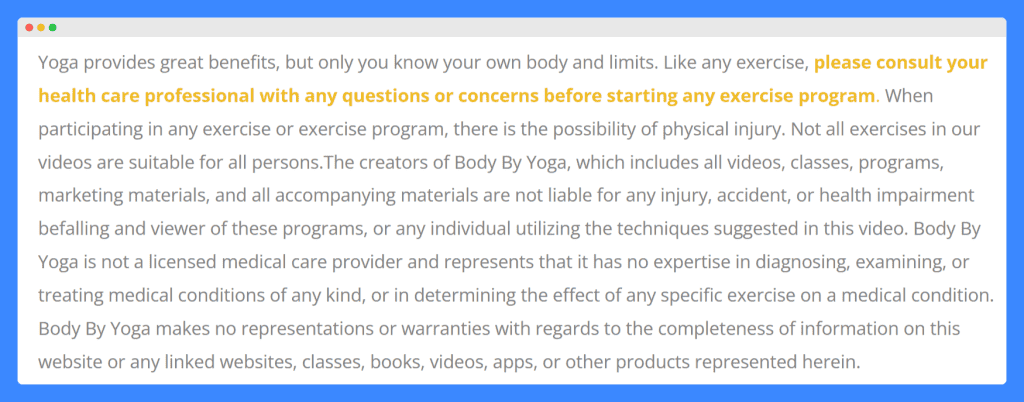
Through this medical disclaimer, they’re able to set the right expectations and ensure that the readers use the content as a helpful resource rather than a definitive medical guide.
2. Clarification That Content Is for Informational Purposes Only
Here is where you clarify that the content is for educational and informational purposes only. This way, readers understand that it does not constitute any form of professional medical advice or endorsement for specific treatments.
If you’re a medical doctor, it also lets your audience know that the information does not establish a physician-patient relationship, whether express or implied.
3. Directive to Consult a Healthcare Professional
In this part of a medical disclaimer, you’re essentially saying,
“If you have any health concerns, please consult or call your doctor or other qualified healthcare provider.”
By including this statement, you encourage your audience to prioritize their health and avoid self-diagnosis or treatment based solely on the information on your website.
To give you an example, let’s say someone reads an article about managing diabetes and feels their symptoms resonate. This directive would remind them to seek expert advice based on their specific condition.
4. Disclaimer of Liability
This part is where the content provider explicitly states they are not liable for any loss or damage resulting from the use of the information provided on their website.
This includes direct, indirect, incidental, consequential, or punitive damages that may arise from accessing or relying on the content. It’s also where websites say they don’t have full responsibility for the accuracy or reliability of the information presented.
For example, here’s how Modern Foot & Ankle disclaims all liability regarding content on its website:
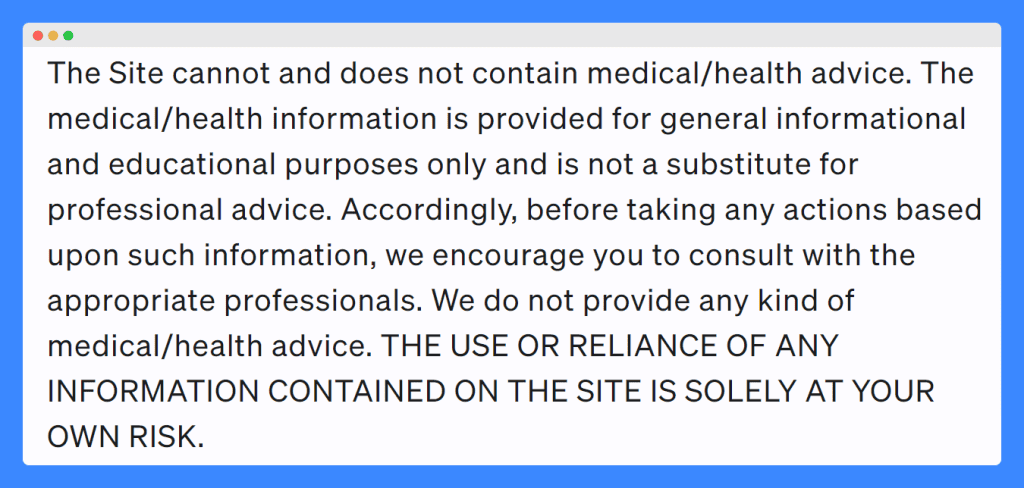
Additionally, when there are links to other websites, this part of the disclaimer also serves to absolve the site of responsibility for their content and practices, reminding users they visit external links at their own risk.
5. Information on the Non-Professional Background of the Content Provider (If Applicable)
For transparency, this section informs users that, unless otherwise noted, the individuals offering information are not qualified health professionals.
In turn, they won’t expect professional medical advice but insights from personal experiences or general research.
6. Urgency Clause for Medical Emergencies
This urgency clause is an indispensable part of any medical disclaimer.
Basically, it stresses the importance of seeking professional help in case of emergency and outlines the limitations of online health information during critical situations.
Here, you can say something like,
“If you believe you are having a specific medical emergency, this website is not a suitable resource. Please go to the nearest hospital or call emergency services if you think you may need urgent medical care.”
7. Limitation on the Applicability of the Information Provided
This component acknowledges that the information provided on your website may not be suitable for everyone. You can say something like,
“The information on this website may not address all questions you may have regarding your specific health condition. Always consult your health care provider and explore related resources to ensure the advice is appropriate for you.”
Here’s how Genevieve Sanders, a registered dietitian nutritionist, put it on her website’s medical disclaimer page:

8. Copyright Notice (If Relevant)
The copyright notice informs users about the lawful restrictions regarding the use, reproduction, or distribution of the website’s material without permission.
This not only safeguards the content creator’s efforts but also maintains the integrity of the information, preventing unauthorized or potentially misleading adaptations.
Here’s how a simple and straightforward copyright notice might be worded:
“Copyright © [Year]. All rights reserved. No part of the information on this site may be reproduced or transmitted in any form or by any means, without prior written permission of the publisher.”
This notice clearly states the limits on how the content can be used, ensuring readers are aware of the legal boundaries and respect the ownership rights of the information provided.
While not strictly part of a medical disclaimer, including a copyright notice at the end can be a good practice to safeguard your intellectual property.
How to Write a Medical Disclaimer for Your Business
When launching a business that deals with health-related content, it’s crucial to include a well-crafted medical disclaimer. Here’s how you can write one:
Step 1: Review Your Website Content
Before writing your disclaimer, thoroughly review the information contained on your website. Identify any areas that might be construed as medical advice. This will help you tailor your disclaimer to address specific concerns.
Step 2: Understand Your Target Audience
Consider who you’re trying to reach with your website. Knowing your target audience will help you write a disclaimer that is clear and easy to understand for your readers.
Step 3: Write Your Disclaimer in Plain Language
Look at other medical disclaimer statement examples from similar businesses to see how they structure their disclaimers. This can provide a framework for what specific points you need to cover based on your services or content.
Step 4: Review and Revise
Finally, have a legal expert review the disclaimer to ensure it’s comprehensive and complies with applicable laws.
PRO TIP: Consider using a medical disclaimer template. This can provide a solid foundation for your disclaimer, ensuring all legal bases are covered and helping to streamline the drafting process.
Where to Display a Medical Disclaimer
A medical disclaimer should be prominently displayed where it is easily accessible to ensure that all users are aware of its terms before engaging with your content.
You can display it in:
- Footer of Your Website: A link to your medical disclaimer in the footer ensures it is accessible from every page.
- About Us or FAQ Page: Adding it to these sections can provide context to your services and the limitations of your content.
- Terms and Conditions Page: Integrating the medical disclaimer with your terms and conditions ensures users recognize the legal boundaries before using your site.
- Before Checkout or Sign-Up Forms: If your website involves transactions or registrations, displaying the disclaimer prominently before users complete these processes reinforces the message at a critical decision point.
- On Blog Posts or Articles: For websites featuring health-related content, include a brief disclaimer or a link to the full disclaimer at the beginning or end of each post.
Medical Disclaimer Examples You Can Learn From
To help you understand how to effectively communicate the scope and limitations of your content, here are some well-crafted medical disclaimer examples from various websites:
1. A Teaspoon of Healing
A Teaspoon of Healing is an exemplary instance of how health and wellness platforms can effectively communicate the scope and limitations of their content through a medical disclaimer.
The blog does an excellent job of detailing that while it provides motivational and educational content, it does not substitute for professional medical advice.

This example of a medical disclaimer also wisely includes a clause about the non-evaluation of claims by the FDA. This adds an extra layer of clarity and protection by informing readers about the unverified nature of any health benefits discussed.
2. Fire Fitness
If you run a fitness-related website, check out Fire Fitness’ short medical disclaimer. By stating that the website does not provide diagnoses or treatments, it stresses the importance of seeking professional healthcare advice.

The repeated affirmations that the website’s content should not be relied upon for any medical or health-related decisions underscore the non-medical nature of the information.
This ensures users understand that the fitness guidance provided is not a substitute for professional healthcare consultation.
3. WebMD
WebMD stands out as a premier example of how comprehensive medical disclaimers should be integrated into a large-scale health information platform.
Its disclaimer articulates that the content is provided for informational purposes only, not as a substitute for professional medical advice, diagnosis, or treatment. Image Source
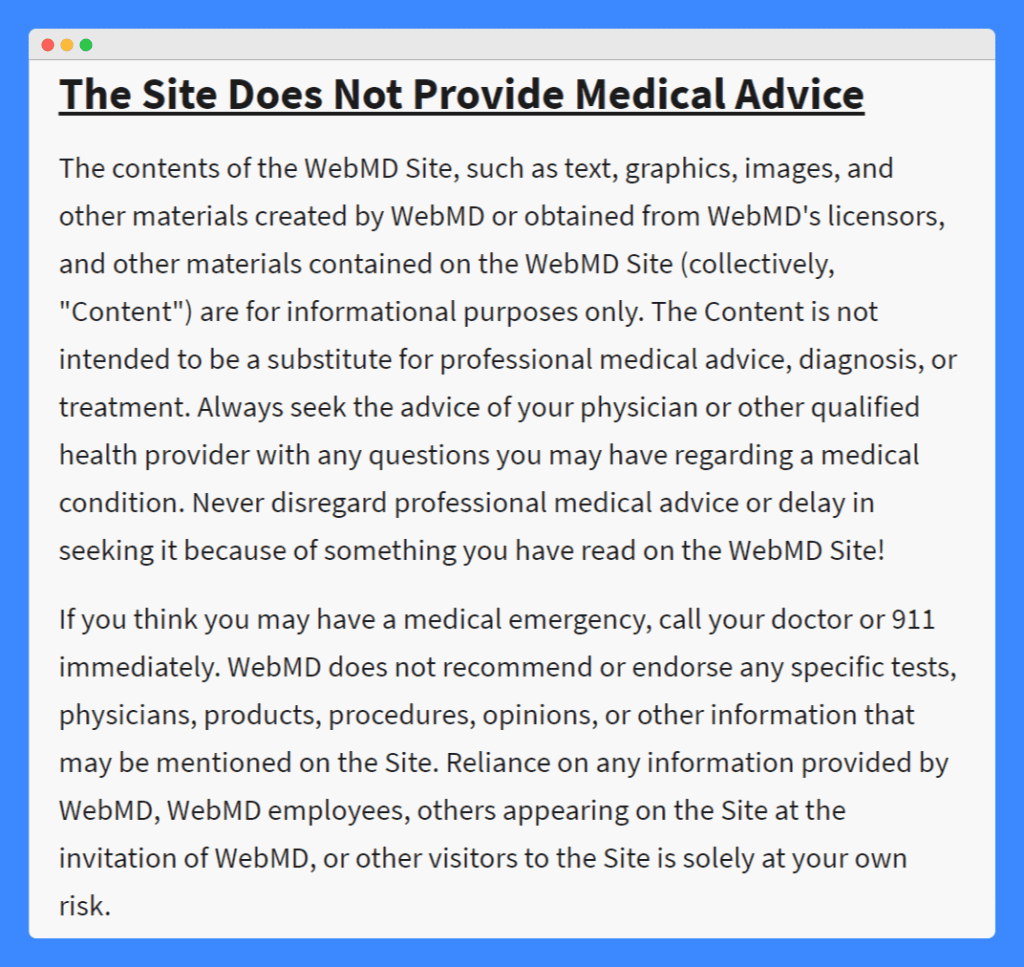
Additionally, it includes explicit directions for handling medical emergencies—directing users to seek immediate professional help rather than relying on online content.
4. Dietitian Insights
Dietitian Insights provides an excellent example of a medical disclaimer that emphasizes the author’s professional background.
The disclaimer clearly states that the dietitians on the website are not medical doctors or physicians. This helps manage user expectations and ensures they understand the limitations of the information provided.
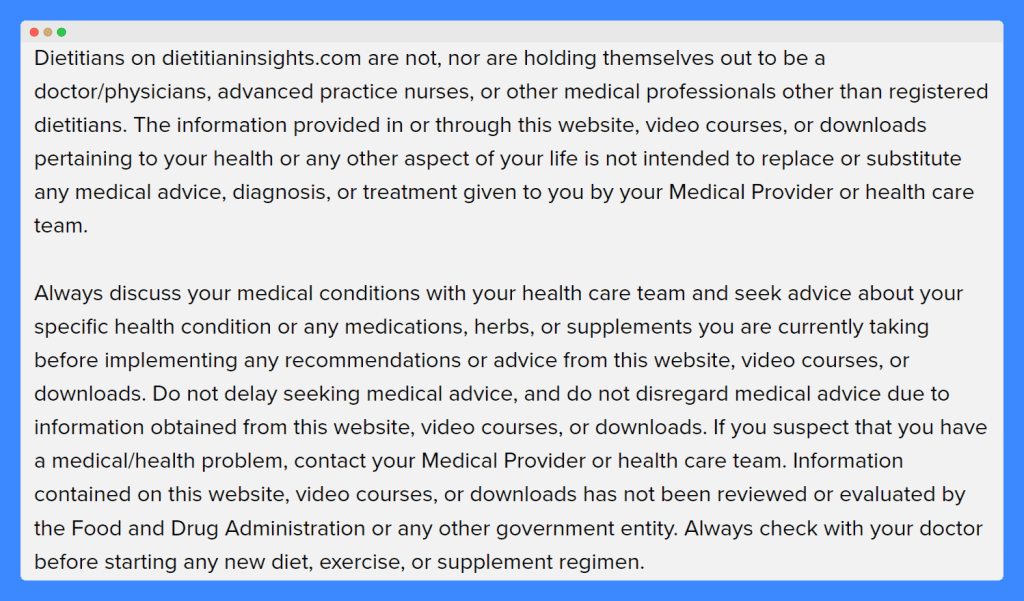
Furthermore, it includes specific calls to action such as discussing medical conditions and medications with a doctor and seeking immediate medical attention if needed.
This comprehensive approach demonstrates a commitment to responsible information sharing and user safety.
5. Nourished Natural Health
Nourished Natural Health offers a thorough medical disclaimer that adeptly addresses the particular concerns associated with alternative medicine.
For example, it clearly states that the information provided is for educational purposes only, stemming from the author’s personal practice experience and research.

Additionally, the disclaimer highlights that using the website’s information or participating in its programs does not establish a healthcare provider-patient relationship, which is vital for legal clarity and user understanding.
Medical Disclaimer Template
This medical disclaimer template is offered as a starting point for drafting your own disclaimer for your blog or website. While it provides a basic framework, it’s important to remember that this is only a general guide. For full legal protection, be sure to tailor the content to your specific needs and include any additional relevant information that applies to your situation.
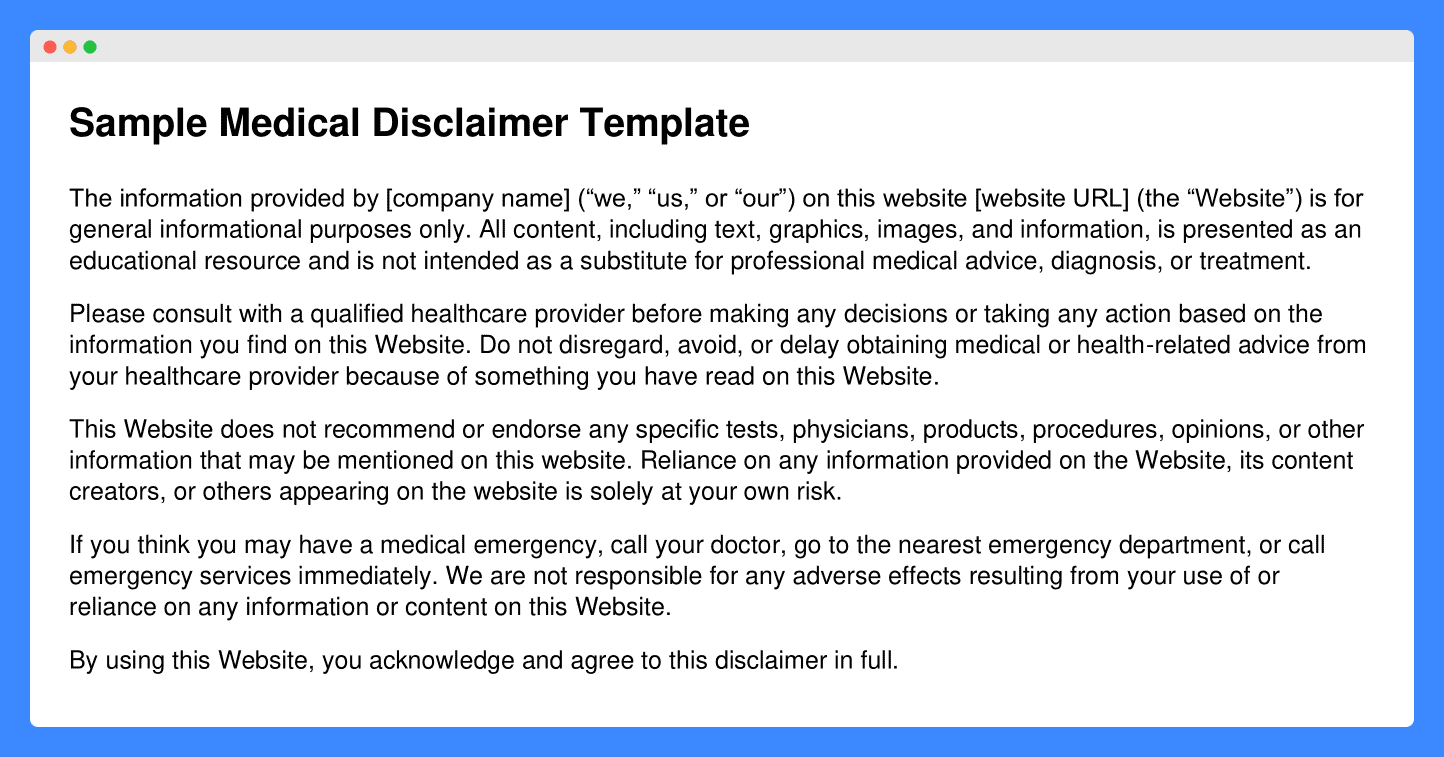
Frequently Asked Questions
Can a medical disclaimer completely protect me from liability?
A medical disclaimer can significantly reduce liability risks but cannot guarantee complete protection. Pair disclaimers with other legal safeguards and best practices for full coverage.
Is a medical disclaimer necessary for all health-related content?
Yes, a medical disclaimer is necessary for all health-related content. It clarifies the limitations of the information and encourages users to consult professionals.
Do medical disclaimers apply to all forms of content?
Yes, medical disclaimers should apply to all forms of content, including written, audio, and video.
Do I need a medical disclaimer if I am a licensed healthcare professional?
Yes, even as a licensed healthcare professional, a medical disclaimer is essential. It clarifies that online content is not personalized advice and encourages users to seek direct consultation.
How often should I update my medical disclaimer?
Update your medical disclaimer annually or whenever legal regulations or your content changes. Regular reviews ensure it remains accurate and compliant with current laws and industry standards.



